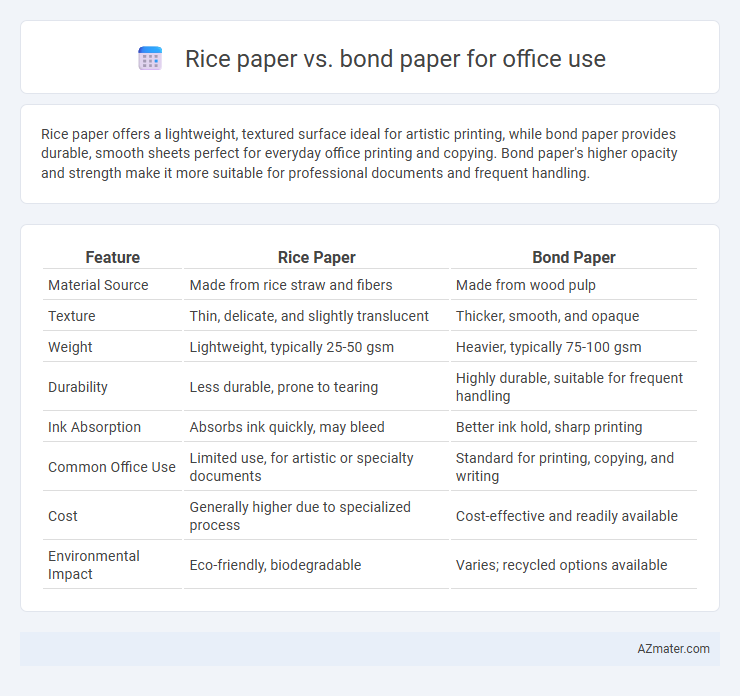Rice paper offers a lightweight, textured surface ideal for artistic printing, while bond paper provides durable, smooth sheets perfect for everyday office printing and copying. Bond paper's higher opacity and strength make it more suitable for professional documents and frequent handling.
Table of Comparison
| Feature | Rice Paper | Bond Paper |
|---|---|---|
| Material Source | Made from rice straw and fibers | Made from wood pulp |
| Texture | Thin, delicate, and slightly translucent | Thicker, smooth, and opaque |
| Weight | Lightweight, typically 25-50 gsm | Heavier, typically 75-100 gsm |
| Durability | Less durable, prone to tearing | Highly durable, suitable for frequent handling |
| Ink Absorption | Absorbs ink quickly, may bleed | Better ink hold, sharp printing |
| Common Office Use | Limited use, for artistic or specialty documents | Standard for printing, copying, and writing |
| Cost | Generally higher due to specialized process | Cost-effective and readily available |
| Environmental Impact | Eco-friendly, biodegradable | Varies; recycled options available |
Introduction: Understanding Rice Paper and Bond Paper
Rice paper, traditionally made from the pith of the rice plant, offers a delicate, translucent texture often favored for artistic and calligraphic purposes. Bond paper, a high-quality durable paper commonly used in offices, is designed for everyday printing, copying, and official documents due to its sturdiness and smooth surface. Understanding the distinct material compositions and typical applications of rice paper and bond paper aids in selecting the appropriate type for specific office tasks.
Material Composition and Manufacturing Differences
Rice paper is made from natural fibers such as mulberry, hemp, or bamboo, resulting in a lightweight, textured surface ideal for artistic or traditional applications. Bond paper, primarily composed of wood pulp with chemical additives, features a smoother, more uniform finish designed for durability and high-quality printing in office environments. The manufacturing process for rice paper involves traditional methods like soaking and pressing fibers, while bond paper undergoes industrial bleaching, refining, and coating to ensure strength and consistency.
Surface Texture and Finish Comparison
Rice paper features a delicate, fibrous surface texture that offers a unique tactile experience and a natural, handcrafted finish, ideal for artistic or specialty office projects. Bond paper typically has a smooth, uniform surface with a matte or slightly glossy finish, which enhances print clarity and is preferred for everyday office documents and professional presentations. Surface texture differences directly impact ink absorption and visual appeal, making rice paper suitable for textured effects and bond paper for crisp, clean print results.
Printability: Which is Better for Office Printers?
Rice paper is typically thin, translucent, and fragile, making it less suitable for high-speed office printers due to potential jams and ink bleed-through. Bond paper, designed for durability and smooth texture, offers reliable printability with crisp text and graphics, making it the preferred choice for everyday office printing tasks. Its compatibility with various ink types and printer models ensures consistent quality and minimal maintenance issues.
Writing Experience: Ink Absorption and Smudging
Rice paper offers a unique writing experience with its smooth texture and moderate ink absorption, which helps reduce smudging when using fountain pens or calligraphy inks. Bond paper, commonly used in offices, provides consistent ink absorption but tends to allow more smudging with wet ink due to its porous surface. Choosing between the two depends on the pen type and the desired balance between ink sharpness and drying time during office tasks.
Durability and Strength in Daily Office Tasks
Rice paper, known for its delicate texture and lightweight quality, lacks the durability and strength required for intensive daily office tasks such as printing, copying, or frequent handling. Bond paper, engineered specifically for office use, offers superior tensile strength and resistance to tearing, making it ideal for documents that undergo regular handling and filing. The robustness of bond paper ensures reliable performance in printers and copiers, minimizing jams and wear-related damages.
Cost Analysis: Affordability for Office Budgets
Rice paper, typically more expensive due to its artisanal production and specialty use, is less cost-effective for standard office printing and documentation needs. Bond paper offers a significantly lower price per sheet, making it a budget-friendly choice for high-volume printing in office environments. Selecting bond paper helps organizations maintain cost efficiency while meeting everyday office paper demands.
Environmental Impact and Sustainability
Rice paper, made from natural fibers like rice straw or hemp, offers a biodegradable and eco-friendly alternative to traditional bond paper, which is primarily produced from wood pulp and involves more intensive chemical processing. The sustainability of rice paper is enhanced by its renewable raw materials and lower energy consumption during manufacturing, reducing its carbon footprint compared to bond paper. Using rice paper in office settings can significantly decrease deforestation and chemical waste, promoting a greener and more sustainable workplace environment.
Practical Office Applications: Suitability and Limitations
Rice paper offers a unique texture and thinness making it ideal for artistic presentations, calligraphy, and formal certificates, but its delicate nature limits durability for heavy-duty office tasks. Bond paper is highly suitable for everyday office use due to its strength, smooth surface, and excellent ink absorption, making it reliable for printing, copying, and document handling. While bond paper supports high-volume printing and reliable document storage, rice paper is best reserved for specialty applications requiring a distinctive aesthetic rather than routine office operations.
Conclusion: Choosing the Right Paper for Office Needs
Rice paper offers a unique texture and aesthetic ideal for artistic presentations or formal invitations, while bond paper provides durability and smoothness suited for everyday office documents such as reports, memos, and letters. Bond paper's higher tensile strength and compatibility with standard printers make it the practical choice for frequent printing and copying tasks. Selecting the right paper depends on balancing the need for visual appeal with functional performance in typical office workflows.

Infographic: Rice paper vs Bond paper for Office use
 azmater.com
azmater.com